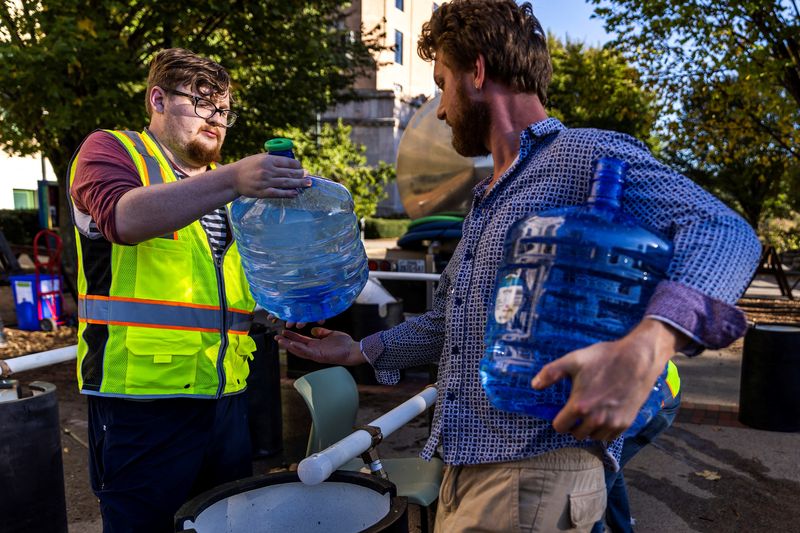By Karl Plume
ASHEVILLE, North Carolina (Reuters) -Tens of thousands of North Carolina residents remained without running water on Wednesday, six days after Hurricane Helene slammed into Florida and carved a destructive path through much of the U.S. Southeast, killing more than 180 people.
The powerful storm inundated the western part of the state with catastrophic flooding, destroying pipes, damaging water plants and cutting off power.
One-fifth of the 1 million residents in the western half of North Carolina either had no water at all or low system pressure on Wednesday, according to an online state database. About 1 million homes and businesses across five states remained without electricity, according to website Poweroutage.us.
In hard-hit Asheville, the municipal water supply system, which serves more than 150,000 people, was badly damaged. Many residents have been warned to expect dry faucets for days or even weeks while pipes are repaired; those with water have been urged to boil it before consuming.
A steady stream of people were filing on Wednesday into Pack Square Park, where the city had set up a food and water distribution hub.
A dozen volunteers distributed drinking water from a makeshift tap system with PVC pipes attached to a tanker truck. Nearby, volunteers distributed donated ready-to-eat meals and plastic water bags to those who had no containers or jugs.
David Shoham, a professor from East Tennessee State University who was waiting for supplies, has been without water and power since Friday.
He had filled up his bathtub ahead of the storm but has since drawn down his reserve after washing dishes.
“It’s just the reality,” he said. “There’s nothing we can do about it individually. We just have to trust that our institutions are going to step up and get services restored. Yeah, it’s frustrating. But who am I going to complain to? The man upstairs?”
Jordan Lance, owner of Buxton Chicken Palace, and three of his chefs filled multiple buckets and containers, hauling them away in a wagon. The group is preparing hot meals three times a day at a nearby food hall.
“We’re gonna be doing big batches of jambalaya coming up, steaming some rice, getting some hot food out for folks,” Lance said. He got choked up when asked how his business would fare without running water, possibly for weeks.
People in North Carolina obtain their water from a patchwork of sources, depending on where they live. In major cities, water comes from large water plants, while in remote areas some residents are served by small neighborhood systems or rely on private wells.
Water distribution sites have been set up at several locations. Both the county and the city paid for private supplies of water to be trucked in, and the state and the Federal Emergency Management Agency have supplied drinking water for distribution around the area.
DESPERATE FOR WATER
Helene came ashore in Florida late on Thursday as a powerful Category 4 hurricane before turning its fury on much of the Southeast, as flash floods destroyed homes and ripped victims away from their families.
The storm washed out both the main pipes and backup pipes at North Fork, one of three water treatment plants serving the Asheville watershed, officials said. Another plant, DeBruhl, could not be reached after the storm blocked the access road with debris.
Both the state’s National Guard and the U.S. Army Corps of Engineers are helping to return the plants to normal operations, city officials said. The system’s third main plant, Mills River, was struggling at reduced capacity.
At least 61 people died in Buncombe County, which includes Asheville, according to authorities.
That elevated the death toll to at least 189 people in six states, according to CNN.
Rachel Simpson, 33, felt lucky to have weathered the storm with only minor damage to her Asheville home.
But she said it has been difficult with no water to bathe, wash clothes or flush toilets.
“The city says it’ll be at least four weeks before the water comes back on,” she said. “Right now we’re getting by the best we can. All the water we have now we’re getting from friends.”
Harrison Fahrer, 37, co-founder of the west Asheville brew house Cellarest Beer Project, knows his problems pale in comparison to those of people whose houses and businesses didn’t survive. But he’s not sure how he’ll make it without water.
“You turn on the spigot and all it does is hiss,” he said. “If we can’t brew, we can’t pay our bills, our loans, our rent, utilities.”
BIDEN, HARRIS SURVEY DAMAGE
As search-and-rescue teams continued to comb through wreckage for the missing and deliver water, food and aid to residents, President Joe Biden visited the state to survey the washed-out roads, smashed bridges and felled power lines.
Vice President Kamala Harris, in the middle of a presidential campaign against Republican former President Donald Trump, traveled to Georgia on Wednesday, two days after Trump visited the state.

The water crisis has impeded businesses, hospitals and schools in and around Asheville as locals try to get back to normal.
“The biggest concern for getting students back to school is water,” Asheville City Schools Superintendent Maggie Fehrman said at a press conference on Wednesday. “Without water, we just simply cannot bring students back or staff back into our building.”

